|
|

Product Numbers: CX-TRIP2 and CX-TRIP4
This document provides instructions for installing the Token Ring interface processor (TRIP) in your Cisco 7000 and Cisco 7500 series routers. The TRIP provides two or four IEEE 802.5 Token Ring network interfaces.
The sections in this document include the following:
Before beginning the installation, read this entire document to ensure that you have all the necessary tools and equipment and that you have the correct modules for your system configuration.
This section contains a detailed description of the Token Ring interface processor (TRIP). The TRIP, shown in Figure 1, provides two or four Token Ring ports for interconnection with IEEE 802.5 and IBM Token Ring media. The TRIP uses the IBM 16/4-Mbps chipset with an imbedded performance enhanced interface driver and 16.7 MHz bit slice processor for high speed processing. The speed on each port is set independently with a software command for either 4 or 16 Mbps. The TRIP firmware (microcode), which contains card-specific software instructions, resides in a ROM in socket U41. You may need to replace this component in the future to enable new features or enhancements (if so, replacement instructions will be provided with the replacement component in an upgrade kit). The TRIP and all other interface processors support online insertion and removal (OIR), which allows you to remove and install a TRIP while the system is operating, without shutting down system power.
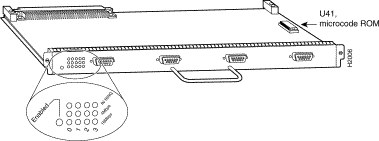
Interface processor slots are accessed from the rear of the chassis. The TRIP can be installed in any available interface processor slot. Each port on the TRIP requires a media access unit (MAU) to connect the DE-9TRIP connectors to the external Token Ring networks.
The enabled LED light on the TRIP lights to indicate the following status of the TRIP:
If any of these conditions is not met, or if the initialization fails for other reasons, the Enabled LED does not light.
When a Token Ring interface is configured by using software commands, three LEDs for each port indicate the following:
You will need an 802.5 MAU or a multistation access unit (MSAU) to provide the interface between the TRIP Token Ring interfaces and the external ring, and a Token Ring lobe cable between each TRIP port and the MAU or MSAU. Lobe cables connect each Token Ring station (TRIP port) to the MAU or MSAU, and patch cables can connect adjacent MSAUs to form one large ring.
TRIP ports operate at either 4 or 16 Mbps. The default speed for all TRIP ports is 4 Mbps, which you can change to 16 Mbps on any port using the configuration command ring-speed n, where n is the speed (4 or 16) in Mbps. The speed of each Token Ring port must match the speed of the ring to which it is connected. Before you enable the Token Ring interfaces, ensure that each is set for the correct speed, or it can bring down the ring.
 | Caution Each TRIP port must be configured for the same ring speed as the ring to which it is connected, either 4 or 16 Mbps. If the port is set for a different speed, it will cause the ring to beacon, which effectively brings the ring down and makes it inoperable. |
The Token Ring ports on the TRIP are DB-9 (PC type) receptacles that require Type 1 or Type 3 lobe cables. Type 1 lobe cables use shielded twisted pair cable and terminate at the network end with a large MAU plug. (See Figure 2.) Type 3 lobe cables use either shielded or unshielded twisted pair (UTP) cable and terminate at the network end with an RJ-11 plug. (See Figure 2.) The TRIP end of both cable types is a DB-9 plug.
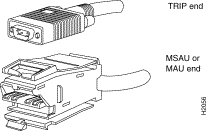
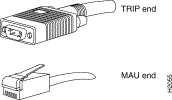
The term Token Ring refers to both IBM's Token Ring Network, which IBM developed in the 1970s, and to IEEE 802.5 networks. The IEEE 802.5 specification was modeled after, and still closely shadows, IBM's network. The two types are compatible, although the specifications differ slightly.
Token Ring and IEEE 802.5 are token passing networks, which move a small frame, called a token, around the network. Possession of the token grants the right to transmit; a station with information to transmit must wait until it detects a free token passing by.
The IBM Token Ring specifies a star topology, with all end stations connected through a device called a multistation access unit (MSAU). IEEE 802.5 does not specify any topology, although most implementations are based on a star configuration with end stations attached to a device called a media access unit (MAU). Also, IBM Token Ring specifies twisted-pair cabling, whereas IEEE 802.5 does not specify media type. Most Token Ring networks use shielded twisted-pair cabling; however, some networks that operate at 4 Mbps use unshielded twisted-pair cable. Table 1 shows a comparison of the two types.
| Network Type | Data Rates | Stations/ Segment | Topology | Media | Signaling | Access Method | Encoding |
|---|---|---|---|---|---|---|---|
IBM Token Ring network | 4, 16 Mbps | 260 shielded twisted-pair | Star | Twisted pair | Baseband | Token passing | Differential Manchester |
IEEE 802.5 network | 4, 16 Mbps | 250 | Not specified | Not specified | Baseband | Token passing | Differential Manchester |
In the typical Token Ring network shown in Figure 4, lobe cables connect each Token Ring station (TRIP port) to the MSAU (or MAU), and patch cables connect adjacent MSAUs (or MAUs) to form one large ring.
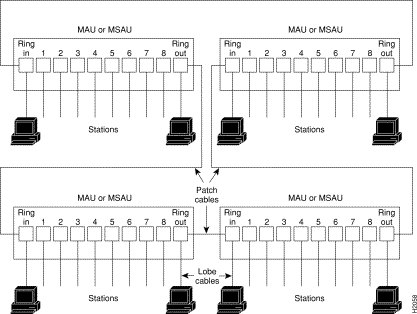
All TRIP ports support both 4- and 16-Mbps operation and early token release. The default for all ports is for 4 Mbps operation and early token release disabled. Both states are enabled with configuration commands in the configuration mode. To enable 16 Mbps, specify the slot/port address and use the configuration command ring-speed 16; to return to 4 Mbps operation, use the command ring-speed 4. To enable and disable early token release, specify the slot/port address and use the configuration command [no] early token release. For complete descriptions and examples of software commands, refer to the related software configuration documentation.
Network interfaces reside on modular interface processors, which provide a direct connection between your external network and the high speed Cisco Extended Bus (CxBus) in the Cisco 7000 series routers, and the CyBus in the Cisco 7500 series routers.
Figure 5 and Figure 6 show the rear of the Cisco 7000 series routers: the seven-slot Cisco 7000 and the five-slot Cisco 7010. Access to the processor slots and the removable power supplies is from the rear, as shown. Two slots are reserved for the Route Processor (RP), which contains the system processor, and the Switch Processor (SP) (or Silicon Switch Processor [SSP]), which performs packet switching functions. The remaining slots support any combination of network interface types: channel attachment, serial, Ethernet, Fast Ethernet, multichannel interface, Token Ring, Fiber Distributed Data Interface (FDDI), or High-Speed Serial Interface (HSSI).
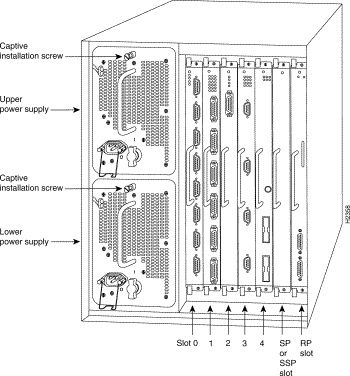
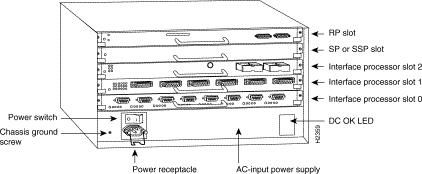
The Cisco 7500 series consists of three router models: the Cisco 7505, the Cisco 7507, and the Cisco 7513. All three models provide high reliability, availability, serviceability, and performance. The three systems support multiprotocol, multimedia routing, and bridging with a wide variety of protocols and any combination of Ethernet, Fast Ethernet, Token Ring, Fiber Distributed Data Interface (FDDI), serial, multichannel, channel attachment, and High-Speed Serial Interface (HSSI) media. Network interfaces reside on modular interface processors, which provide a direct connection between the high-speed, 1.067-gigabits-per-second (Gbps) Cisco Extended Bus (CyBus) and the external networks.
Figure 7 shows the rear of the five-slot Cisco 7505 router. In the Cisco 7505, one slot (4) is reserved for the Route Switch Processor (RSP1), which contains the system processor and performs packet switching functions. Slots 0 through 3 are for interface processors.
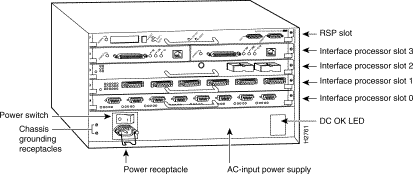
Figure 8 shows the rear of the seven-slot Cisco 7507 router. In the Cisco 7507, up to two slots (2 and 3) are reserved for the Route Switch Processor (RSP2), which contains the system processor and performs packet switching functions. Slots 0 and 1, and 4 through 6 are for interface processors.
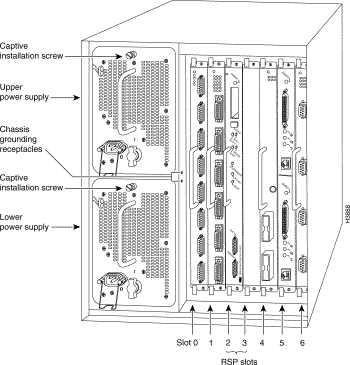
Figure 9 shows the rear of the Cisco 7513, with two AC-input power supplies installed. Two slots (6 and 7) are reserved for the second generation Route Switch Processor (RSP2), which contains the system processor and performs packet switching functions. Slots 0 through 5, and 8 through 12 are for interface processors.
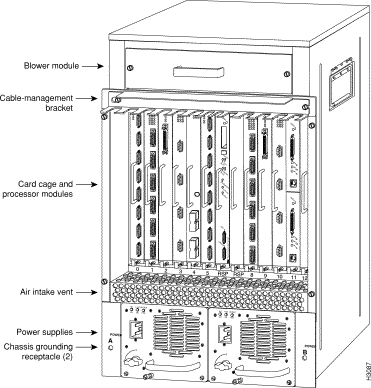
This section provides a list of parts and tools you will need to perform the installation, and safety and ESD-prevention guidelines to help you to avoid injury and damage to the equipment. It also provides a detailed description of the online insertion and removal (OIR) function to help you perform online installation successfully and avoid error message and system restarts. If you are installing a new TRIP, be sure to review the equipment descriptions and distance limitations in the section "Distance Limitations for Token Ring Connections" on page 11 when preparing your site and planning network connections.
The maximum transmission distance is not defined for IEEE 802.5 (Token Ring) networks. Shielded twisted-0pair cabling is most commonly used for rates of 4 and 16 Mbps. Twisted pair cabling is more susceptible to interference than other types of cabling; therefore, the network length and repeater spacing should be planned accordingly.
Before you install the TRIP, determine the ring speed (4 or 16 Mbps) of each ring to be connected to the server. There is no factory default for the interface speed; you must set the speed of each interface (within the setup command facility or with the ring-speed command) before you bring the interface up and insert it into the ring with the no shutdown command.
If an interface has an undefined or incorrect ring speed and is not shut down, the ring will beacon. This effectively takes the ring down and makes it inoperable.
Following are safety guidelines that you should follow when working with any equipment that connects to electrical power or telephone wiring.
Follow these basic guidelines when working with any electrical equipment:
Use the following guidelines when working with any equipment that is connected to telephone wiring or to other network cabling:
Electrostatic discharge (ESD) damage, which can occur when electronic cards or components are improperly handled, results in complete or intermittent failures. The TRIP comprises a printed circuit board that is fixed in a metal carrier. Electromagnetic interference (EMI) shielding, connectors, and a handle are integral components of the carrier. Although the metal carrier helps to protect the board from ESD, use a preventive antistatic strap whenever handling the TRIP. Handle the carriers by the handles and the carrier edges only; never touch the boards or connector pins.
Following are guidelines for preventing ESD damage:
 | Caution Periodically check the resistance value of the antistatic strap. The measurement should be between 1 and 10 megohms. |
Online insertion and removal (OIR) allows you to remove and replace interface processors while the system is operating; you do not need to notify the software or shut down the system power. This section describes the mechanical functions of the system components and stresses the importance of following the correct procedures to avoid unnecessary restarts or card failures. This section is for background information only. Subsequent sections provide specific procedures for removing and installing a TRIP. All CxBus and CyBus interface processors support OIR
Each processor module contains a bus connector with which it connects to the system backplane. The bus connector is a set of tiered pins, in three lengths. The pins send specific signals to the system as they make contact with the backplane. The system assesses the signals it receives and the order in which it receives them to determine what event is occurring and what task it needs to perform, such as reinitializing new interfaces or shutting down removed ones. For example, when you insert an interface processor, the longest pins make contact with the backplane first, and the shortest pins make contact last. The system recognizes the signals and the sequence in which it receives them. The system expects to receive signals from the individual pins in this logical sequence, and the ejector levers help to ensure that the pins mate in this sequence.
When you remove or insert an interface processor, the backplane pins send signals to notify the system, which then performs as follows:
1. Rapidly scans the backplane for configuration changes and does not reset any interfaces.
2. Initializes all newly inserted interface processors, noting any removed interfaces and placing them in the administratively shutdown state.
3. Brings all previously configured interfaces on the interface processor back to the state they were in when they were removed. Any newly inserted interfaces are put in the administratively shut down state, as if they were present (but unconfigured) at boot time. If a similar interface processor type has been reinserted into a slot, then its ports are configured and brought online up to the port count of the original interface processor.
OIR functionality enables you to add, remove, or replace interface processors with the system online, which provides a method that is seamless to end users on the network, maintains all routing information, and ensures session preservation.
When you insert a new interface processor, the system runs a diagnostic test on the new interfaces and compares them to the existing configuration. If this initial diagnostic test fails, the system remains off line for another 15 seconds while it performs a second set of diagnostic tests to determine whether or not the interface processor is faulty and if normal system operation is possible.
If the second diagnostic test passes, which indicates that the system is operating normally and the new interface processor is faulty, the system resumes normal operation but leaves the new interfaces disabled. If the second diagnostic test fails, the system crashes, which usually indicates that the new interface processor has created a problem on the bus and should be removed.
The system brings online only interfaces that match the current configuration and were previously configured as up; all other interfaces require that you configure them with the configure command. On interface processors with multiple interfaces, only the interfaces that have already been configured are brought online. The new interface remains in the administratively shutdown state until you configure it and bring it online.
 | Caution While the TRIP supports OIR, the system may indicate a hardware failure if you fail to follow proper procedures. |
The function of the ejector levers (see Figure 10) is to align and seat the card connectors in the backplane. Failure to use the ejectors and insert the interface processor properly can disrupt the order in which the pins make contact with the backplane. Follow the TRIP installation and removal instructions carefully, and review the following examples of incorrect insertion practices and results:
It is also important to use the ejector levers when removing an interface processor to ensure that the board connector pins disconnect from the backplane in the logical sequence expected by the system. Any RP, SP, or interface processor that is only partially connected to the backplane can hang the bus. Detailed steps for correctly performing OIR are included with the following procedures for installing and removing a TRIP.
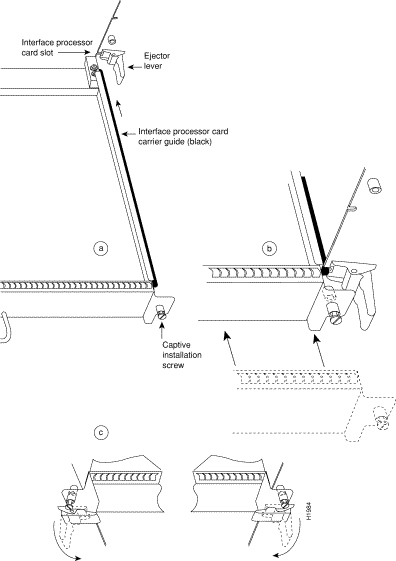
Verify that you have all of the parts and optional equipment you will need to install the TRIP. If you need additional equipment, contact a service representative for ordering information.
A disposable ESD-prevention wrist strap is included with all new components and upgrade kits; use it to prevent damage to equipment from electrostatic discharge.
The following sections describe the procedures for removing or installing a TRIP in a Cisco 7000 and Cisco 7500 series router. The OIR function allows you to install and remove a TRIP without first shutting down the system; however, you must follow the instructions carefully. Failure to insert the TRIP properly can cause system error messages indicating a board failure. For a complete description of OIR, refer to the section "Online Insertion and RemovalAn Overview" on page 13.
Each unused interface processor slot contains an interface processor filler (which is an interface processor carrier without an interface board) to keep dust out of the chassis and to maintain proper air flow through the interface processor compartment. If you are installing a new TRIP that is not a replacement, you must first remove the interface processor filler from an unused slot, proceed to the section "Removing an Interface Processor Filler." If you are replacing a TRIP, proceed to the section "Removing a TRIP."
Select an unused interface processor slot for the new TRIP and remove the interface processor filler as follows:
Step 1 Choose an available slot for the TRIP and ensure that there is enough clearance to accommodate any interface equipment that you will connect directly to the ports (for example, transceivers that connect directly to the ports overlap equipment on adjacent interface processors).
Step 1 Use a screwdriver to loosen the captive installation screws on the interface processor filler. (See Figure 10.)
Step 2 Place your thumbs on both ejectors and simultaneously pull them both outward to release the TRIP from the backplane connector (in the opposite direction from that shown in Figure 10c).
Step 3 Grasp the handle with one hand and pull the filler straight out of the slot, keeping your other hand under the carrier to guide it. (See Figure 11.) Keep the carrier parallel to the backplane.
Step 4 Store the interface processor filler for future use.
To help prevent dust and contaminants from entering the chassis, do not leave the interface processor slot open. Immediately proceed to the section "Installing a TRIP" on page 18.
The TRIP supports OIR; therefore, you need not shut down the interface or the system power when removing a TRIP. If you are replacing a failed TRIP, remove the existing board first, then replace the new TRIP in the same slot.
Figure 11 shows proper handling of an interface processor for installation in the Cisco 7010 and Cisco 7505 models. The processor slots are oriented horizontally in the Cisco 7010 and Cisco 7505, and vertically in the Cisco 7000, Cisco 7507, and Cisco 7513.
To remove a TRIP, follow these steps:
Step 1 Disconnect the all cables from the TRIP ports (if you are moving the TRIP to another port, this step is not necessary).
Step 2 Use a screwdriver to loosen the captive installation screws at both ends of the TRIP. (See Figure 10.)
 | Caution Always use the ejector levers to remove or install the TRIP. Failure to do so can cause erroneous system error messages indicating a board failure. |
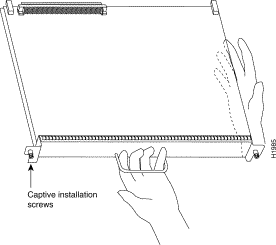
Step 3 Place your thumbs on the ejector levers and simultaneously pull both of the ejectors outward (in the opposite direction from that show in Figure 10c) to release the TRIP from the backplane connector.
Step 4 Use the handle to carefully pull the TRIP straight out of the slot, keeping your other hand under the carrier to guide it. (See Figure 11.) Keep the TRIP parallel to the backplane.
Step 5 Place the removed TRIP on an antistatic mat or foam pad, or place it in an antistatic bag if you will return it to the factory.
Step 6 If the interface processor slot is to remain empty, install an interface processor filler (MAS7K-BLANK) to keep dust out of the chassis and to maintain proper air flow through the interface processor compartment.
To help prevent dust and contaminants from entering the chassis, do not leave the interface processor slot open. Immediately proceed to the section "Installing a TRIP" on page 18.
The TRIP slides into the open interface processor slot and directly to the backplane. The interface processors are keyed to guide pins on the backplane, so the TRIP can be installed only in an interface processor slot. (See Figure 5, Figure 6, Figure 7, Figure 8, or Figure 9, depending on your chassis.) Figure 10 shows the functional details of inserting an interface processor and using the ejectors. Figure 11 shows proper handling of an interface processor during installation.
 | Caution Remove or insert only one interface processor at a time. Allow at least 15 seconds for the system to complete its discovery and initialization tasks before removing or inserting another interface processor. Disrupting the sequence before the system has completed it verification can cause the system to interpret hardware failures. |
The TRIP supports ring speeds of 4 and 16 Mbps. Follow these steps to install a TRIP:
Step 1 Ensure the console terminal is connected to the RP (or RSP) Console port and that the console is turned ON.
Step 2 Hold the TRIP handle with one hand, and place your other hand under the carrier to support the TRIP and guide it into the slot. (See Figure 11.) Avoid touching the card or any connector pins.
 | Caution To prevent ESD damage, handle interface processors by the handles and carrier edges only. |
Step 3 Place the back of the TRIP in the slot and align the notch on the carrier with the groove in the slot. (See Figure 10.)
Step 4 While keeping the TRIP parallel to the backplane, carefully slide it into the slot until the back of the faceplate makes contact with the ejector levers, then stop. (See Figure 10b.)
 | Caution Always use the ejector levers when installing or removing processor modules. A module that is partially seated in the backplane will cause the system to hang and subsequently crash, and shoving or slamming the interface processor into the slot can damage the backplane and connector pins. |
Step 5 Using your thumbs, simultaneously push both ejectors inward until the TRIP is pushed entirely into its slot. (See Figure 10c.)
Step 6 Tighten both of the captive installation screws.
Step 7 Attach network interface cables or other connection equipment to the interface ports. (See Figure 12).
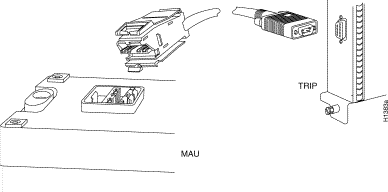
Step 8 Check the status of the interfaces as follows:
The TRIP contains one enabled LED and a row of three LEDs for each Token Ring interface. (See Figure 11). The row of three LEDs indicate the speed (4 or 16 Mbps) of the interface and whether the interface is inserted in the ring.
When you install the TRIP in an interface processor slot and turn ON the power (if the power was turned off), the following events occur:

You can modify the startup configuration for Cisco 7000 series and Cisco 7500 series routers through the software command interpreter called EXEC. To configure the interfaces for interface processors, you can use either one of the following EXEC commands:
setupThe setup command facility can be used after first time startup to make basic changes at any time. The changes you make will affect only the changed elements' current memory values that are stored in nonvolatile memory.
The privileged EXEC command configure enables you to perform advanced configurations such as specifying interfaces.
The EXEC interprets the commands you enter and carries out the corresponding operations. You can list available EXEC commands by entering a question mark (?). You also can enter a question mark to obtain more information about commands. For example, enter terminal ? to obtain a list of terminal commands or show ? to obtain a list of show commands.
Before you use the setup or the configure command, you must have privileged access to the EXEC command interpreter. The system prompt for the privileged level ends with a pound sign (#) instead of an angle bracket (>).
The EXEC enable command allows access to the privileged level, prompting for a password if one has been set with the enable-password configuration command.
Follow these steps to enter the privileged level of the EXEC.
Step 1 At the EXEC prompt for a router, enter the enable command:
Router> enable
The EXEC prompts you for a privileged level password:
Password:
Step 2 Enter the password.
For security purposes, the password is not displayed. (Also note that the password is case sensitive). When you enter the correct password, the system displays the privileged mode system prompt:
Router#
To configure Token Ring interfaces using the setup EXEC command facility, follow the instructions in the section "Using the Setup Command" on page 21. To configure the Token Ring interfaces by using the configure EXEC command, follow the instructions in the section "Using the Configure EXEC Command" on page 22.
The setup command facility identifies all interfaces (including the Token Ring interfaces for the ports on the TRIP) that are installed and prompts you for configuration information for each installed interface. When you finish configuring one interface, the setup command facility prompts you for the next, continuing until each interface has been configured.
When you enter the setup command facility after first time startup, you must run through the entire dialog until you come to the interface you want to change. Note that when you use the setup command after first time startup, the default values indicated within the brackets in the System Configuration Dialog are the values last set using the setup command facility or left as defaults.
After you choose to continue with the setup command (by answering yes to the system configuration dialog prompt), the remainder of the script is the actual configuration process. The dialog prompts you first for global system parameters, then for configuration information for each interface. The existing configuration is displayed as the default, in brackets ([ ]), at the end of each prompt. Press Return to accept the default settings.
Step 1 After you access the privileged level of the EXEC, as described in the section "Using the EXEC Command Interpreter" on page 20, enter the setup command to begin the setup facility:
Router# setup
Step 1 The following script is displayed on the screen, with the name of your router as the default in the brackets.
-System Configuration Dialog-
At any point you may enter a question mark '?' for help.
Refer to the 'Getting Started' Guide for additional help.
Default settings are in square brackets '[]'.
Continue with configuration dialog? [yes]: (Use Ctrl-c to abort configuration at any prompt)
Configuring global parameters:
Enter host name [Router]: sandbox
Step 2 To accept the default and keep the router name, press Return. (If you do want to change the name of the router, enter the new name before pressing Return.)
Step 3 Proceed through the remainder of the global parameter prompts, using the Return key to accept the defaults.
After the global parameters are configured, the system prompts you for interface configuration information, one interface at a time. Following is a partial display of the script for a previously configured interface:
Configuring interface parameters:
Configuring interface Token Ring0:
Is this interface in use [yes]:
Tokenring ring speed (4 or 16) [16]
Configure IP on this interface? [yes]:
IP address for this interface: 131.108.6.67
(remainder of display text omitted)
Step 4 To accept the default at each prompt and retain the existing configuration information, press the Return key. When you reach the scripts for configuring new interfaces, enter the new configuration information at each prompt.
When all interfaces are configured, the system displays the entire configuration script followed by a prompt for which there is no default (you must enter yes or no):
Use this configuration [yes/no]:
Step 5 To use the configuration you created, enter yes. To discard the configuration file and begin the configuration process again, enter no.
If you entered yes at the prompt, the following message displays:
Press RETURN to get started!
The configuration process is complete. Proceed to the section "Checking the Configuration" on page 24. It provides show commands you can use to display and verify the configuration information.
The configure EXEC command allows you to configure the interfaces for interface processors in the Cisco 7000 series and Cisco 7500 series. At the privileged command level, enter the ? command to display a list of privileged level EXEC commands.
To display information about the interface, including the software and hardware versions and the controller status, use the show controller cxbus command. To display statistics about the interfaces, use the show interfaces command.
Use the show interfaces command to determine which interfaces you need to configure and to determine the interface type, slot numbers, and port numbers.
The number of ports you configure depends on the number of ports available on the interface processor. For example, if you install a TRIP with four ports in slot 0, configure the Token Ring interface for each of these ports as follows: 0/1, 0/2, 03/ and 0/4. The maximum number of ports available on the TRIP is four.
After identifying the port numbers for the interfaces, configure the interfaces as described in the section "Basic Configuration Guidelines" on page 23.
Following are instructions for a basic configuration: enabling an interface and specifying IP routing. You might also need to enter other configuration subcommands, depending upon the requirements for your system configuration. (Configuration subcommands are described in the Router Products Configuration Guide, available on UniverCD or in print.)
Step 1 After you access the privileged level of the EXEC as described in the section "Using the EXEC Command Interpreter" on page 20, enter the configure command:
Router# configure terminal Enter configuration commands, one per line. End with CNTL/Z.
Step 2 Specify the first Token Ring interface to configure by entering the subcommand interface type slot/port. For example, if you are configuring the Token Ring interface 0 for a TRIP installed in slot 4, enter the following command:
Router(config)# interface tokenring 4/0
Step 3 If IP routing is enabled on the system, you can assign an IP address and subnet mask to the interface with the ip address configuration subcommand as follows:
Router(config-int)# ip address ip address subnet mask
Step 4 Change the default shutdown state and enable the interface:
Router(config-int)# no shutdown
When you enable the interface by using the no shutdown command, the LED for 4 Mbps or 16 Mbps is turned on after about 5 seconds. The IN RING LED for that interface is turned on about 5 to 18 seconds later, when the port is initialized and is connected to the ring.
Step 5 Enter any additional configuration subcommands required.
Step 6 Repeat steps 2 through 5 for each new interface.
Step 7 When all new interfaces are configured, press Ctrl-Z (hold the Control key down and press the Z key).
Step 8 Write the new configuration to memory by entering the following:
Router# copy running-config startup-config [OK] Router#
Step 9 Enter quit to exit the configuration mode:
Router# quit
You have now completed configuring the Token Ring interfaces. Check the configuration as described in the section "Checking the Configuration."
After configuring the new interface(s) using either the setup command or the configure command, use the EXEC show commands to display status information.
Step 1 To display the current system configuration file, enter the show configuration command:
Router# show configuration
The configuration file for the router is displayed. Check the Token Ring configuration information in the display.
Step 2 To display and check all interfaces, enter the following command:
Router# show interfaces
Each interface is listed along with its assigned IP address. Verify that each new Token Ring interface appears.
Step 3 To obtain detailed status information about a specific Token Ring interface, specify the interface with the following command:
Router# show interface tokenring slot/port
Detailed information about the interface is displayed. The first line of display specifies the interface along with its slot and port number. It indicates whether the hardware is functional and if the line protocol is up or down. If the line protocol is down (and you did not administratively shut it down), or if the hardware is not functioning properly, ensure that the network interface is properly connected and terminated. For explanations of the displayed information, refer to the Router Products Command Reference and the Router Products Command Summary publications.
Step 4 To display the current internal status of the processors, use the show controller command:
Router# show controllers token
The display lists the interfaces connected to each processor and indicates whether the system has identified your new interface. It does not indicate the state of the line or the protocol.
This completes the installation and configuration procedure for the TRIP and associated equipment.
Depending on how it is configured, the Cisco 7000 series router allows the Switch Processor (SP) and interface processors to use updated microcode that is available either in Flash memory on the Route Processor (RP) or on the onboard ROM for each processor. The Cisco 75000 series routers allow the interface processors to use updated microcode that is available either in Flash memory on the Route Switch Processor (RSP) or on the onboard ROM for each processor.
The router supports downloadable microcode, which enables you to upgrade microcode versions without having to physically replace the ROMs on the boards. You can download new microcode versions, store multiple versions in Flash memory, and boot from them, just as you can with the system software images. System software upgrades can also contain upgraded microcode images, which will load automatically when the new software image is loaded.
With downloadable microcode, you should never need to replace the microcode ROM on the board. If, however, replacement is necessary in the future, specific instructions will also be provided with the replacement component in an upgrade kit.
You can download microcode to Flash memory by copying the TFTP image of a microcode version to Flash memory. When the microcode version is available in Flash memory, you can boot the router either automatically or manually from Flash memory. Follow these steps to copy a microcode version from the TFTP server to Flash memory:
Step 1 To display the total amount of Flash memory present, its location, any files that currently might exist in Flash memory and their size, and the amount of Flash memory remaining, use the show flash command.
The following type of output is displayed:
4096K bytes of flash memory on embedded flash (in RP1). file offset length name
0 0x40 53330 trip1-0
1 0xD0D4 51432 sp1-0 [4089412/4194304 bytes free]
Step 2 After you verify that there is sufficient space available in Flash memory for new images, enter the following command:
Router# copy tftp flash
Step 3 Enter the IP address of the remote host:
IP address or name of remote host [255.255.255.255]? ip address
Step 4 Enter the name of the file you want to copy to Flash:
Name of file to copy ? file name
The format of the file name is the name of the interface processor followed by the version number (for example, trip1-0).
Step 5 Confirm that you want the file copied into Flash:
Copy trip1-0 from 131.108.13.111 into flash memory? [confirm] yes
Step 6 If you do not want the other microcode files in Flash memory erased, enter no
OR
If you want Flash erased, enter yes.
Erase flash before writing? [confirm] no
If you answered yes, the Flash memory is erased, and the TRIP microcode is copied to Flash memory. Output similar to the following is displayed:
Zeroing bank...zzzzzzzzzzzzzzzz
Verify zeroed...vvvvvvvvvvvvvvvv
Erasing bank...eeeeeeeeeeeeeeee Loading from 131.108.1.111: !!!!!!!!!!!!!!!!!!!!!!!!!!!!!!!!!!!!!!!!!!!!!!!!!!!!
[OK - 1906676/4194240 bytes]
Verifying via checksum...
Flash verification successful. Length = 1906676, checksum = 0x12AD
If you answered no, the TRIP microcode is copied to Flash memory without any erasure of existing files in Flash.
Step 7 Verify that the microcode has been copied to Flash memory:
Router# show flash
The following type of output is displayed:
4096K bytes of flash memory on embedded flash (in RP1).
file offset length name
0 0x40 53330 trip1-0
1 0xD0D4 51432 sp140-34 [4089412/4194304 bytes free]
Step 8 If you want the TRIP to use the microcode in Flash memory immediately, enter the following commands at the router prompt:
Router# microcode trip flash microcode file name
Router# microcode reload
The microcode reload command immediately enables the TRIP to use the specified microcode file.
Step 9 To ensure that the new microcode is used by the TRIP after a system reboot, add the microcode commands to the configuration file. To access the configuration file, enter the following command:
Router# configure terminal
Step 10 Add the following commands to the configuration file:
microcode trip flash microcode file name
microcode reload
Step 11 To exit the configuration mode, press Ctrl-Z.
Step 12 To write the updated configuration file to the NVRAM, enter the following command:
Router# copy running-config startup-config
Step 13 Verify that the correct microcode version is available in Flash memory:
Router# show controllers token
You have now completed downloading microcode to the Flash memory, downloaded the microcode to the TRIP, added the microcode commands to the configuration file, and updated the NVRAM with the new configuration file.
If any of the interfaces fail to return to their previous state, refer to the troubleshooting procedures in the hardware installation and maintenance publication appropriate to your chassis model.
Cisco Information Online (CIO) is Cisco Systems' primary, real-time support channel. Maintenance customers and partners can self-register on CIO to obtain additional content and services.
Available 24 hours a day, 7 days a week, CIO provides a wealth of standard and value-added services to Cisco's customers and business partners. CIO services include product information, software updates, release notes, technical tips, the Bug Navigator, configuration notes, brochures, descriptions of service offerings, and download access to public and authorized files.
CIO serves a wide variety of users through two interfaces that are updated and enhanced simultaneously—a character-based version and a multimedia version that resides on the World Wide Web (WWW). The character-based CIO (called "CIO Classic") supports Zmodem, Kermit, Xmodem, FTP, Internet e-mail, and fax download options, and is excellent for quick access to information over lower bandwidths. The WWW version of CIO provides richly formatted documents with photographs, figures, graphics, and video, as well as hyperlinks to related information.
You can access CIO in the following ways:
http://www.cisco.com .cio.cisco.com. For a copy of CIO's Frequently Asked Questions (FAQ), contact cio-help@cisco.com. For additional information, contact cio-team@cisco.com.
tac@cisco.com. To obtain general information about Cisco Systems, Cisco products, or upgrades, contact 800 553-6387, 408 526-7208, or cs-rep@cisco.com.
![]()
![]()
![]()
![]()
![]()
![]()
![]()
![]()
Posted: Tue Oct 15 08:04:08 PDT 2002
All contents are Copyright © 1992--2002 Cisco Systems, Inc. All rights reserved.
Important Notices and Privacy Statement.